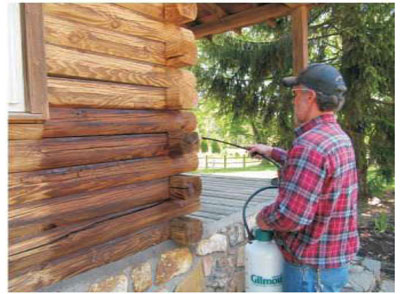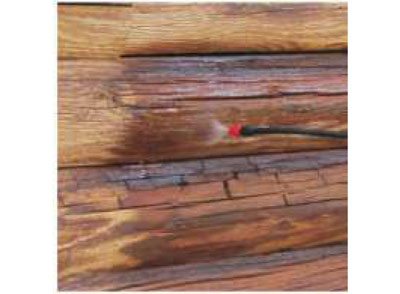
The reason for using this material instead of borax or boric acid is because it has a much higher boron content per pound and is significantly more water soluble than other boron-containing compounds. But what is it about boron that makes it so effective for preserving and protecting wood? In the case of wood consuming insects, like termites and wood-boring beetles, boron disrupts their digestion process by killing the bacteria that allows the insects to digest cellulose. There is also some evidence that boron interferes with the insects’ metabolic systems. These modes of actions do take some time, and it is not unusual for insect activity to continue for several months after being exposed to a borate treatment. However, once eliminated, the wood will be protected from future wood consuming insect infestations as long as the boron remains within the wood’s cellular structure.
In the case of decay fungi, the presence of boron disrupts the cellular production of enzymes that allow the fungi to extract nutrients from the wood. As opposed to insects, a borate treatment will kill decay fungi rather rapidly, usually within a day or two.
Borate Treatment Methods
Pressure Treatments
Pressure treating wood with preservatives dates back to the 19th century when railroad ties were impregnated with creosote under pressure. Since then, a number of chemical formulations have been used for pressure-treating logs and dimensional lumber, but most have been discontinued due to their toxicity or health and environmental hazards. Due to their low mammalian toxicity and environmental friendliness, borates are now being used by a number of pressure-treating companies for treating both logs and dimensional lumber. The one limitation of borate pressure-treated lumber is that it cannot be used for wood in contact with the soil, since the moisture in the soil will extract out the water-soluble borate within a few years.
Dip Treatments
A number of log home manufacturers dip their logs in a solution of borate before they are shipped to the customer. Although there are set standards for the “Dip Diffusion” process, very few companies actually meet these standards, since it requires dipping green, unseasoned logs in a hot, concentrated borate solution and then storing the logs in a covered building for a minimum of two weeks. Most log suppliers simply dip their logs in a borate solution for a few minutes then allow them to dry. Although this procedure does not meet set standards, it has been used for over four decades and as long as the borate concentration in the dipping solution is maintained at or above 10%, we rarely hear of this process not providing adequate protection to new logs.
Topical Treatments
Back in the late 1980s, Perma-Chink Systems developed the very first borate preservative that could be applied to wood in the field during or after construction. Since then, hundreds of thousands of log and conventionally constructed homes have been borate-treated using the technology originally developed by Perma-Chink Systems. What made this possible was combining the borate with a combination of glycols that allow the borate to penetrate into the wood rather than remaining just on the surface. In addition, the glycols increase the efficacy of the boron allowing less applied product to be just, if not more effective than higher concentrations of borate water solutions alone.

Pure borate/water solutions are also used for topical applications, but since they do not contain anything that aids in the penetration of the borate into the wood, we recommend that they be used only on new, un-infested logs and be reapplied any time the home is stripped of its existing finish.
The one limitation of any topically-applied borate is that it must be applied to bare wood. If there is anything on the surface that inhibits the absorption of water into the wood, the borate solution will remain on the surface and no protection will be imparted to the wood itself.
Conclusion
The success rate of properly applied borate treatments is truly astounding. In the 40 years that we have been involved with borate-treated wood, the number of reported complaints is miniscule, and most of them involved insects that do not consume wood for nourishment like carpenter bees, parasitic wasps, house ants, and other pests that are not included on the label. We occasionally get calls about a continuing beetle infestation after a borate treatment, but it’s almost always within a week or two of the product being applied and that’s just not long enough for the borate to completely eliminate an active infestation of wood boring beetles. However, give the borate time to work until the activity ends, that will be the end of the infestation and they never return.
